Hike | Jotunheimen | Norway
Hiking in Jotunheimen National Park in Norway
Text | Anninka Kraus
Photography | Tobias Kraus

Norway
This 6-day trek in Jotunheimen National Park is shared with one of Norway’s most popular day hikes, the Besseggen Ridge, and runs from Gjendesheimen to Gjendebu hut.
It’s one of the most beautiful hikes we’ve ever done and the one we keep on recommending to all our hiking friends. If you’re planning to hike in Jotunheimen, you’ll definitely not be disappointed!
Following this route, you’ll be surrounded by a never-ending scenery of sparkling deep blue fjords and lakes to the backdrop of snow-capped mountains, stunning ridgelines and the most picturesque valleys, from beginning to end.
jump ahead.
Day 1: Gjendesheimen – Lake Bessvatnet
Day 2: Lake Bessvatnet – Glitterheim hut
Day 3: Glitterheim hut – Spitterstulen Mountain Lodge
Day 4: Spitterstulen Mountain Lodge – Leirvassbu hut
Day 5: Leirvassbu hut – Gjendebu hut
Day 6: Gjendebu hut – ferry to Gjendesheim and bus to Otta
related.
Rondane National Park: 4 days hiking in Norway’s oldest national park
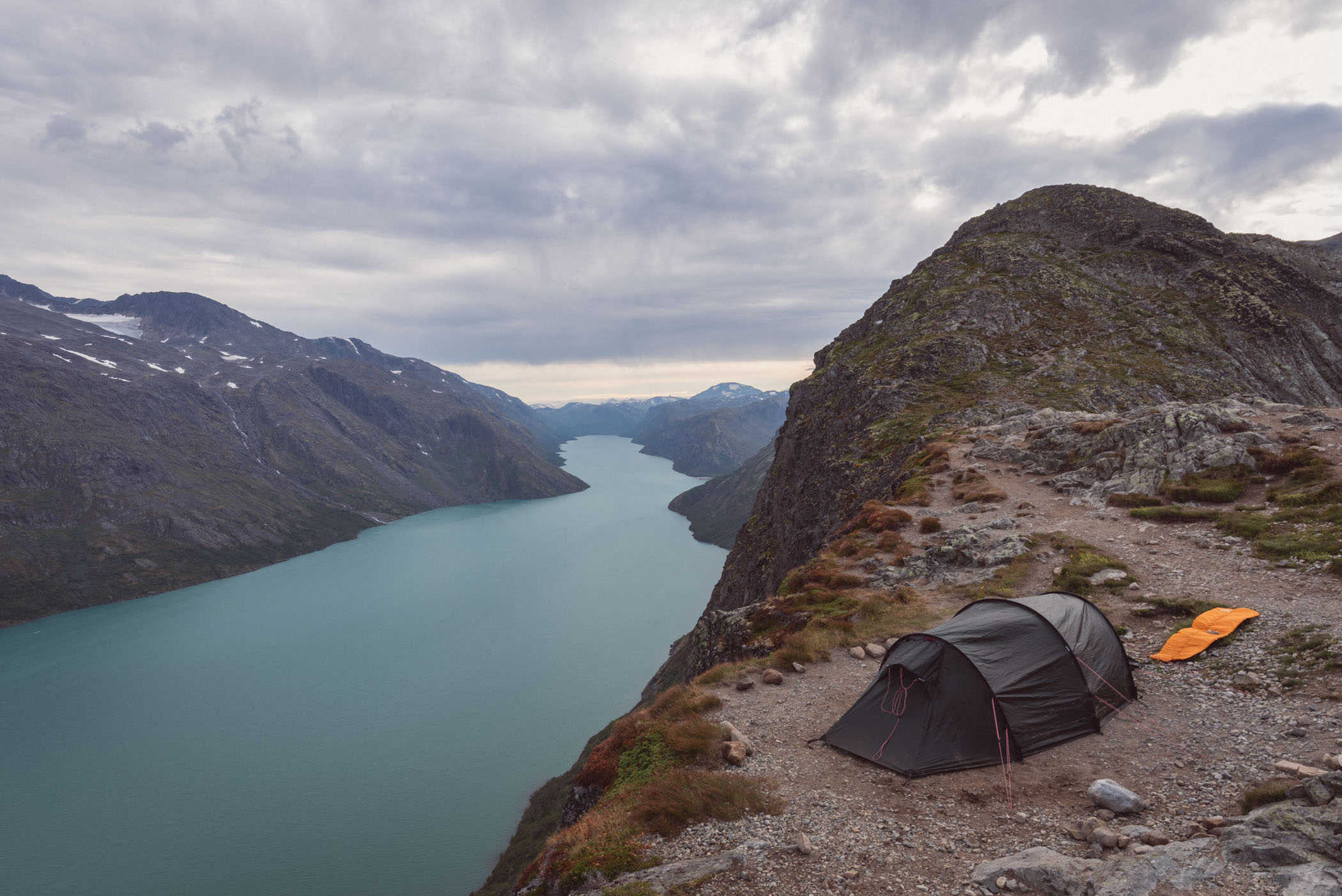
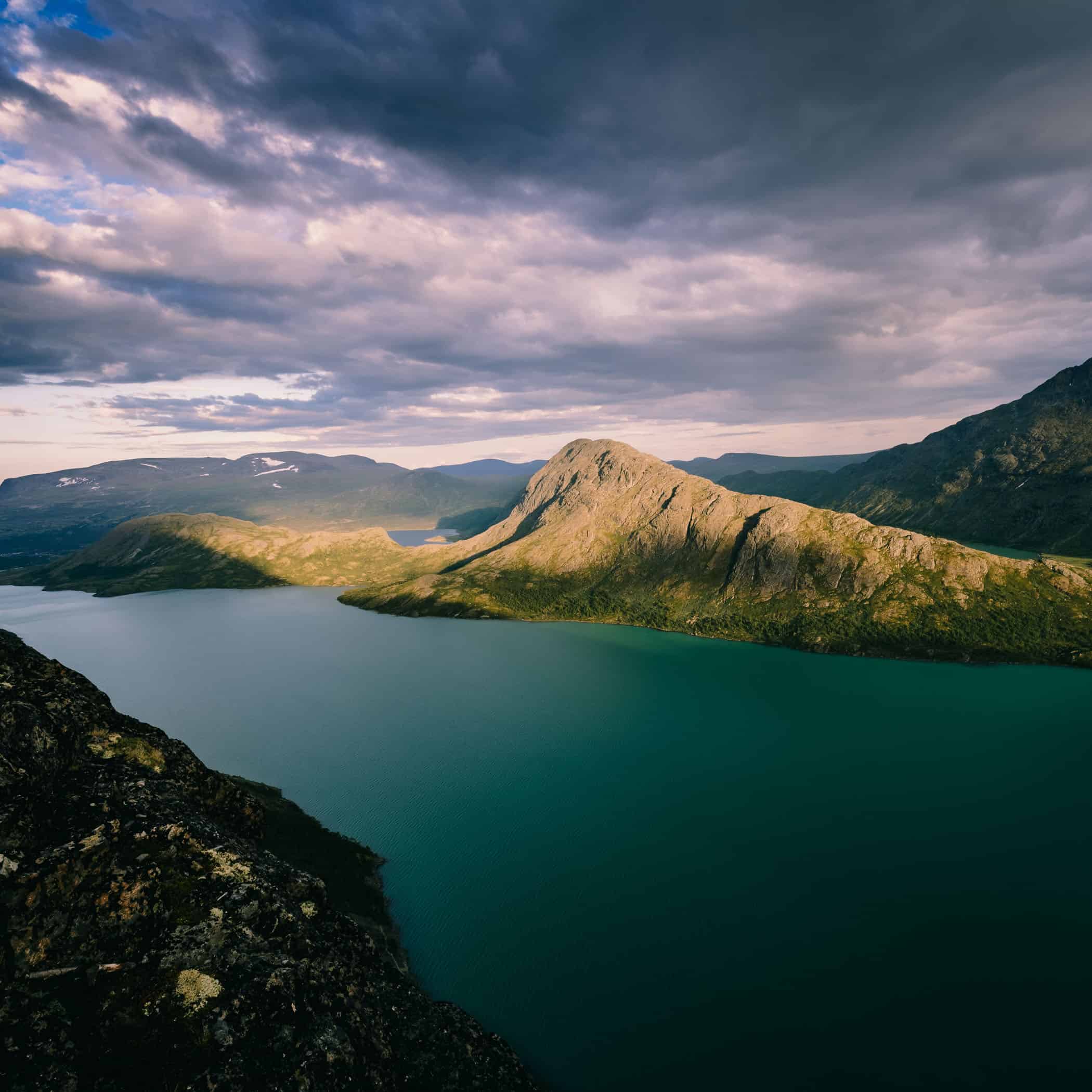



The most spectacular spots I’ve ever spent the night: on the narrow ledge, 50m wide, where Lake Bessvatnet meets the vertical drop of the ridge.
map of our 6-day walk in Jotunheimen National Park
location & park information.
Hot to get to Jotunheimen National Park: Jotunheimen National Park is centrally located in the middle of Norway. The national park is accessible from different directions. The starting point of this tour is Gjendesheim. To get there, you can use public transport or your own car. If you’re taking public transport, catch a train to the nearest train station in Otta. From there you can get the local bus to Gjendesheim.
When to go: The best time of the year for hiking in Jotunheimen National Park is from the middle of July until the end of August. In June and September, the weather can also be great, but the chances of lower temperatures, more rain or even some snow are higher.
Gjendesheimen to Lake Bessvatnet
Getting to Jotunheimen National Park on public transport is possible, but only two buses a day depart Otta for Gjendesheim at the park’s eastern border. The latter is a truly remote spot, I thought when I got off the bus, taking in a wooden shipping pier and a hut overlooking Lake Gjende.
The mountain slopes rising steeply from the emerald water’s edge only reinforced a growing sense of isolation in the wilderness. This was exactly what I had imagined hiking in Norway to be like. Enthusiastic and blissfully unaware of the burden of a 30kg backpack in difficult terrain, I set out for the first leg. An hour into the steep climb however, I was struggling under the weight, and it became obvious that I wouldn’t even make my first overnight stop.
This became apparent not only to me it seemed, but also the steady stream of day tourists coming my way with pitying smiles. This first leg of my 6-day trek was shared with one of Norway’s most popular day hikes, the Besseggen Ridge.
Its trailhead is accessible by public transport as well as by car, and in the school holidays many families and groups of young adults (As in Switzerland, hiking in Norway is popular with all ages) were spending this spectacular summer day in the mountains. They seemed to enjoy the trek itself whereas I only reveled in the views, especially those from Besseggen Ridge at 1380m that fell off steeply to Gjende Lake 400m below.
This is also where I stopped, well short of my target destination for the day, but at one of the most spectacular spots I’ve ever spent the night: on the narrow ledge, 50m wide, where Lake Bessvatnet meets the vertical drop of the ridge.
track details.
Start: Gjendesheimen
End: Lake Bessvatnet
Route: Gjendesheimen – Besseggen Ridge – Lake Bessvatnet
Distance: 7.2km
Time: 4 hours Elevation gain: 749m / loss: 391m (lowest point: 1090m / highest point: 1730m)
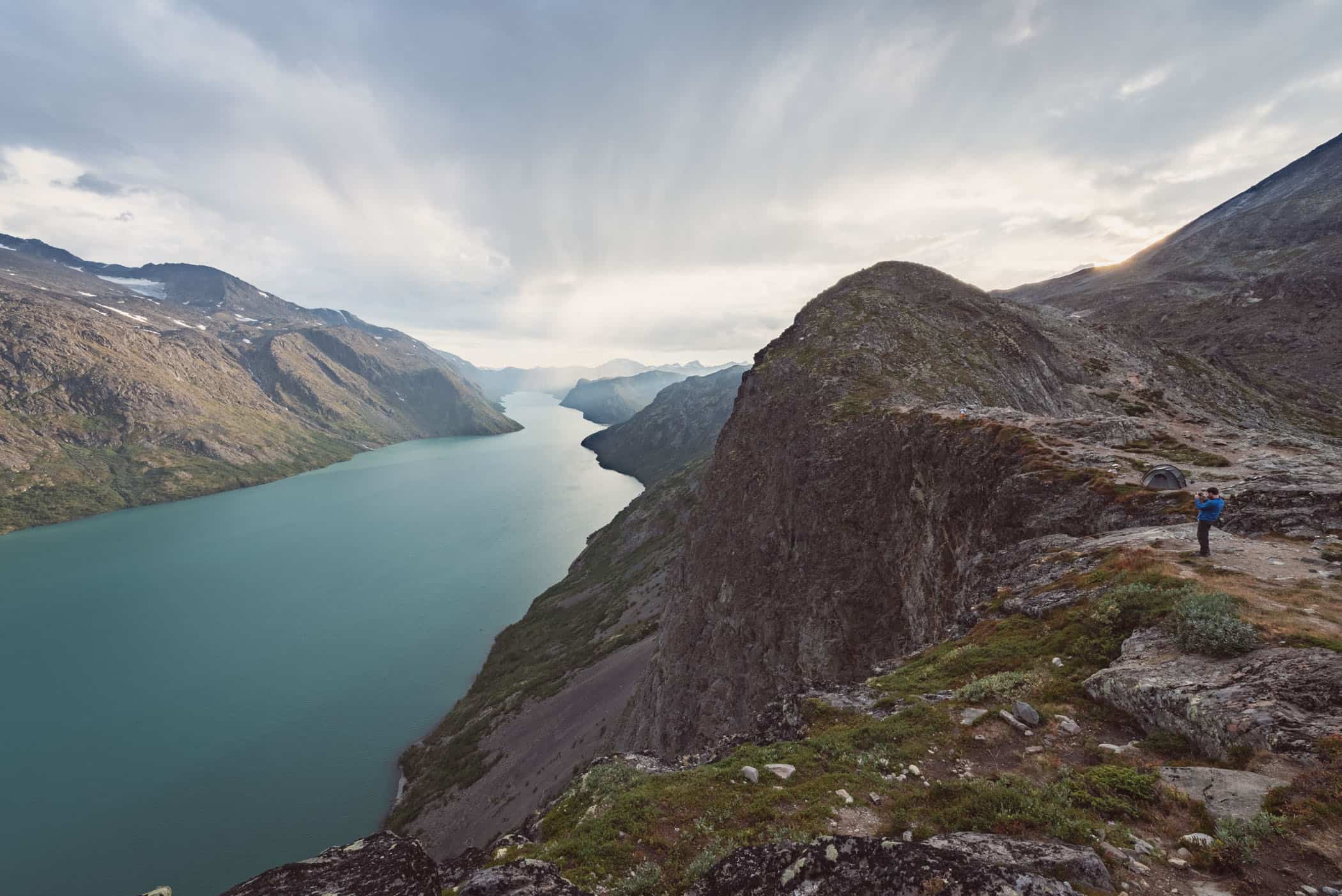

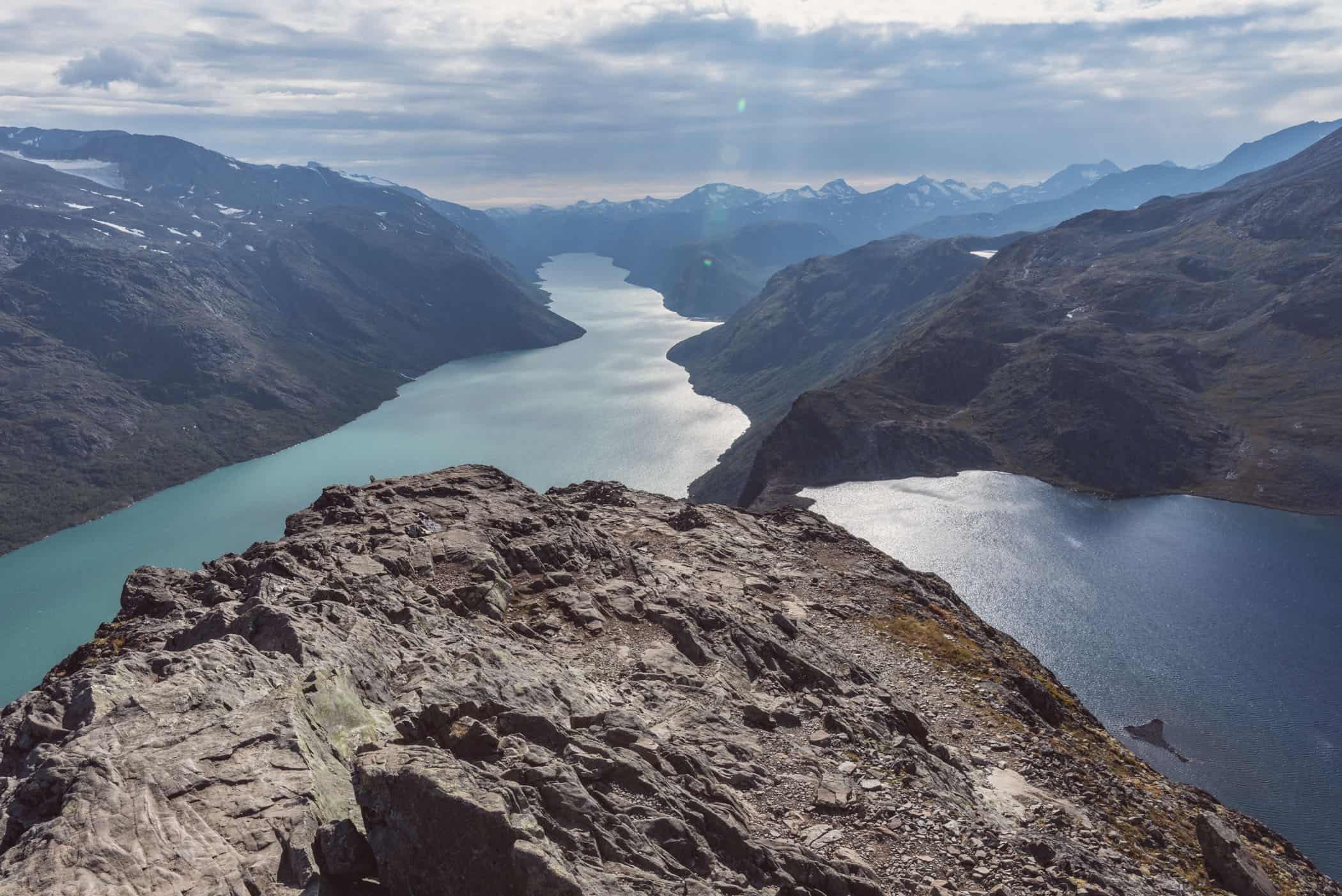
Lake Bessvatnet to near Glitterheim hut
Despite my worry of sleeping through bright daylight I woke late, but still early enough that the crowds of day tourists were nowhere to be seen yet. The bluish-black surface of Lake Bessvatnet on one side, contrasting with the distinctive green water of Lake Gjende on the other, was a splendid sight with not a cloud in the sky.
Almost as much, I enjoyed the solitude I shared with only two hikers who had also spent the night on the ledge. I stayed two hours, just admiring the views and packing up camp, before setting off in the direction of Memurubu hut. 1.5km short of Memurubu, the trail to Glitterheim hut forked off to the right, and a few hundred meters down that path I was suddenly met with an entirely different view: the valley widened and spread out towards Lake Russvatnet at its far end.
After a short descent to the valley floor and another hour walking on slightly sloping terrain, I reached the southern lakeshore. At an altitude of 1000-1500m above sea level, the sun burned on my skin, even this far north. I applied more sunscreen to my sweaty face and arms, then followed the lakeshore for ninety minutes, where the trail towards the pass and Glitterheim hut forked off to the left.
Tackling 600m in elevation to pass the summit was definitely the most challenging section of today’s leg.
It was late in the day, my shoulders were sore from the heavy pack after seven hours hiking, and I was ready to call it a day. I finally finished, just short of the top of the pass, where I came across a grassy patch in between two small streams. It was also the only spot far and wide in this rocky wasteland where I could drive pegs into the ground.
track details.
Start: Lake Bessvatnet
End: close to Glitterheim hut
Route: Lake Bessvatnet – Lake Russvatnet – on the way to Glitterheim hut
Distance: 17.8km
Time: 7:25 hours
Elevation gain: 786m / loss: 607m (lowest point: 1190m / highest point: 1580m)
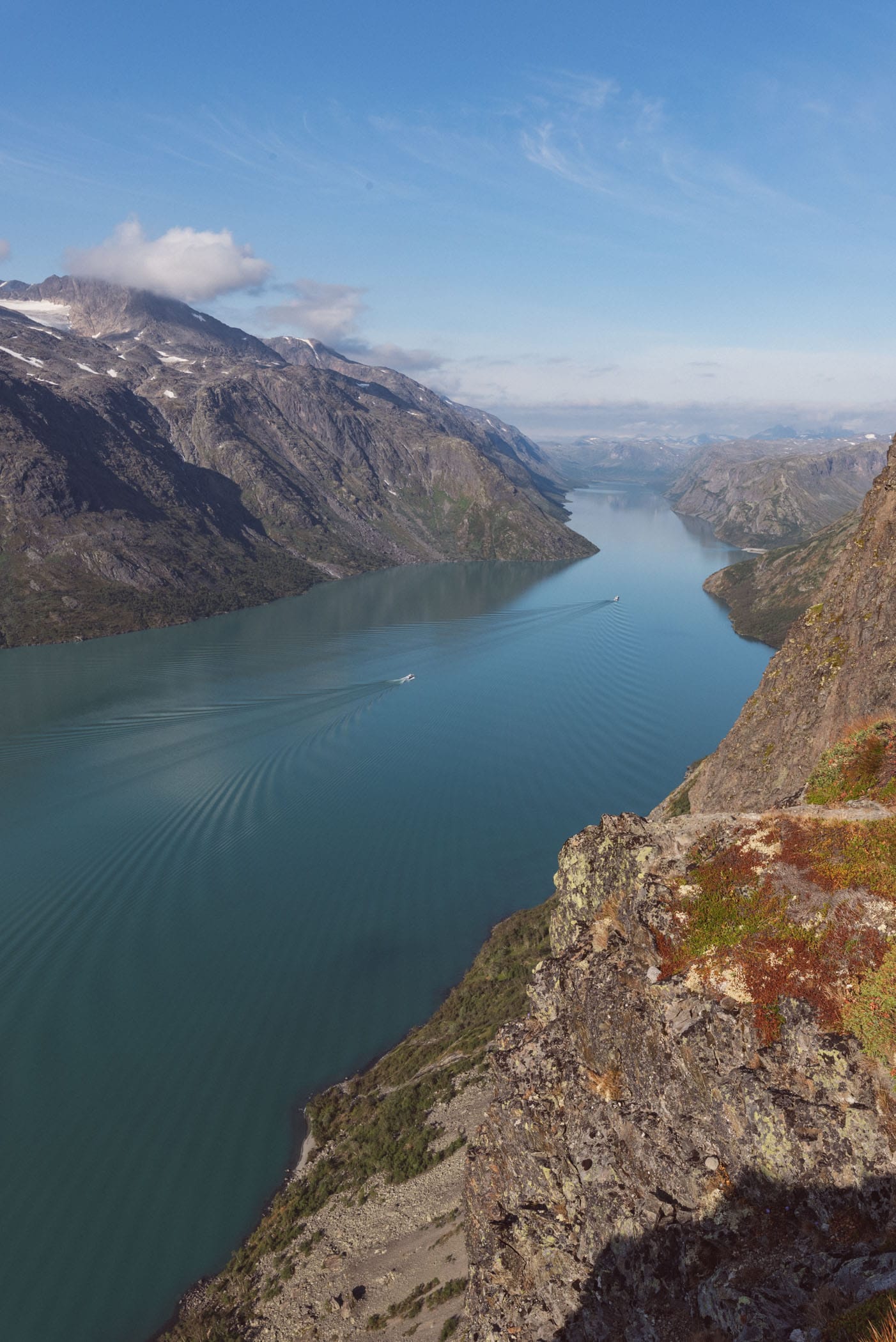

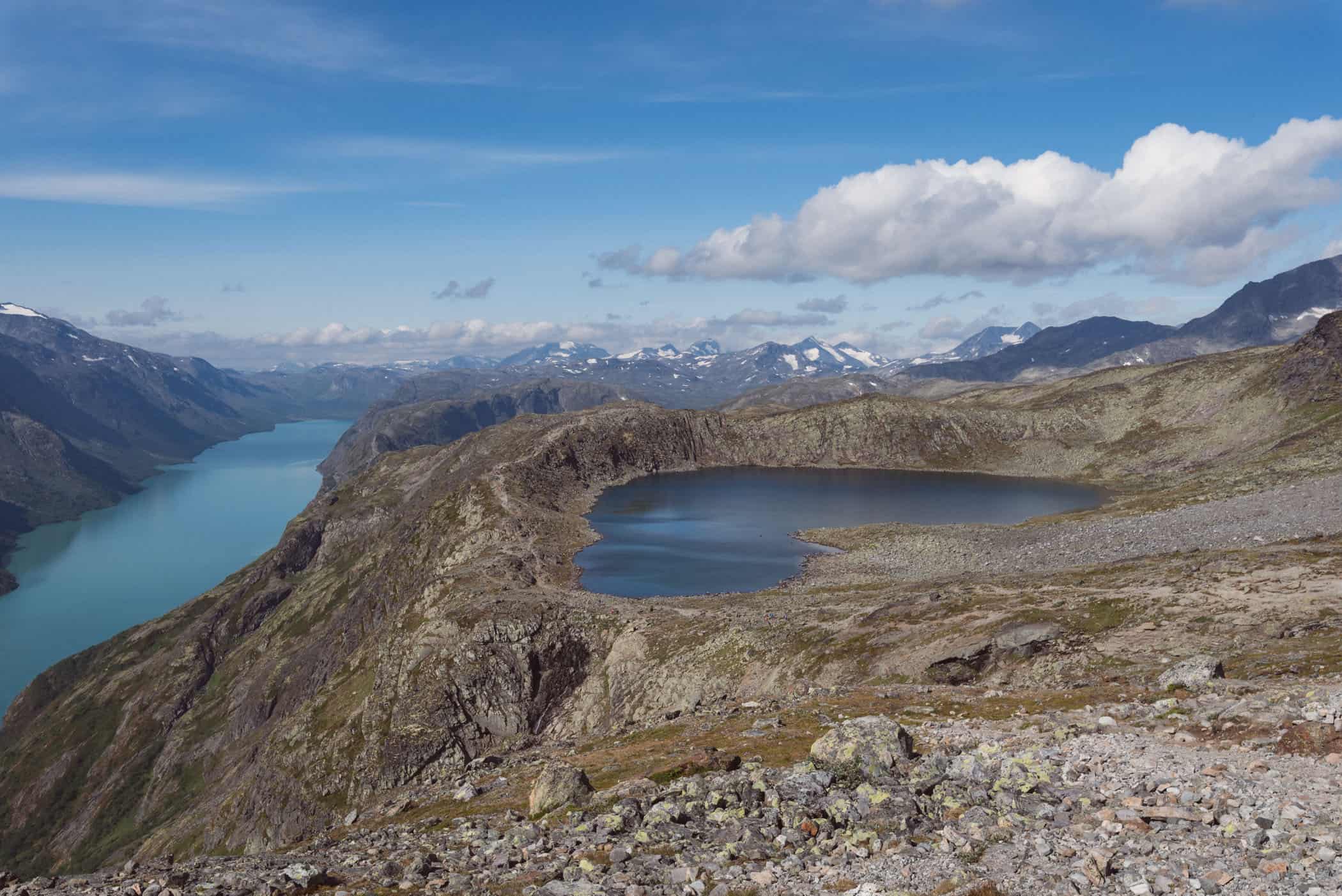

Glitterheim hut to Spitterstulen Mountain Lodge
On my third day hiking in Jotunheimen National Park, I woke to the high-pitched peal of bells. It was a flock of five sheep I had seen from a distance the night before, wearing small bells around their necks. They grazed only a few feet away and at the sight of my sleep drunken face peeking out of the tent, stared at me with an empty quizzical expression that only sheep muster this well.
Though seemingly unperturbed by my presence, they trotted off slowly and continued grazing on the way.
A half-hour into the hike, at the top of the pass, I caught a first glimpse of Glitterheim hut. On my way there, I met a few hikers headed the opposite direction, and at the hut, I was enthusiastically welcomed by Scott, the watchdog. Only when the delicious smell of a cooked lunch wafting out of the kitchen was too much to bear (the next hot meal awaiting me was freeze-dried hiking grub out of the bag for dinner), did I leave this stunning location right on the lake and continued in the direction of Spiterstulen Mountain Lodge northeast of Glitterheim.
Two routes lead from Glitterheim to Spiterstulen. One climbs to the peak of Glittertinden, Scandinavia’s second highest mountain at 2460m. I decided against that painstaking slog up more than 1000m in elevation with a 30kg backpack and chose the other. This second trail led through Skautflye Valley, passed glaciers, snowfields and small mountain lakes and revealed marvelous panoramas of Veodalen Valley.
While this was certainly easier than climbing Glittertinden, the terrain was challenging all the same, and the footing treacherous. Sapped of my strength; scree slopes, rubble and large boulders strewn across the path, slowed my progress to a painstaking slog. Where the trail crossing Glittertinden rejoined mine, I rested shortly to regain my strength for the gradual descent of 400m into Visdalen Valley.
The trail meandered along a string of small hills in a gentle up and down, when after 30min, I arrived on a small high plateau.
The panorama of several glaciers, Visdalen Valley and the Visa River, was breathtaking. Vis a vis the plateau was a majestic glacier, and at its tongue a glacial stream torpedoed into the depth of the valley towards Visa. Spitterstulen Mountain Lodge, a large hotel complex with indoor pool and adjacent campsite in Visdalen Valley on the banks of the Visa River, was impossible to miss and obviously a popular destination.
I was almost blinded by the sun reflecting off a large number of cars parked in front, and straightaway missed the solitude of the previous days. Further upstream, at a spot on the riverbank, the gurgling of water was again the only soundtrack in the wild, on endless replay.
track details.
Start: near Glitterheim hut
End: near Spitterstulen Mountain Lodge
Route: Glitterheim hut – Skauflye Valley – Visdalen Valley – Spitterstulen Mountain Lodge
Distance: 23.5km
Time: 9 hours
Elevation gain: 480m / loss: 930m (lowest point: 1100m / highest point: 1690m)

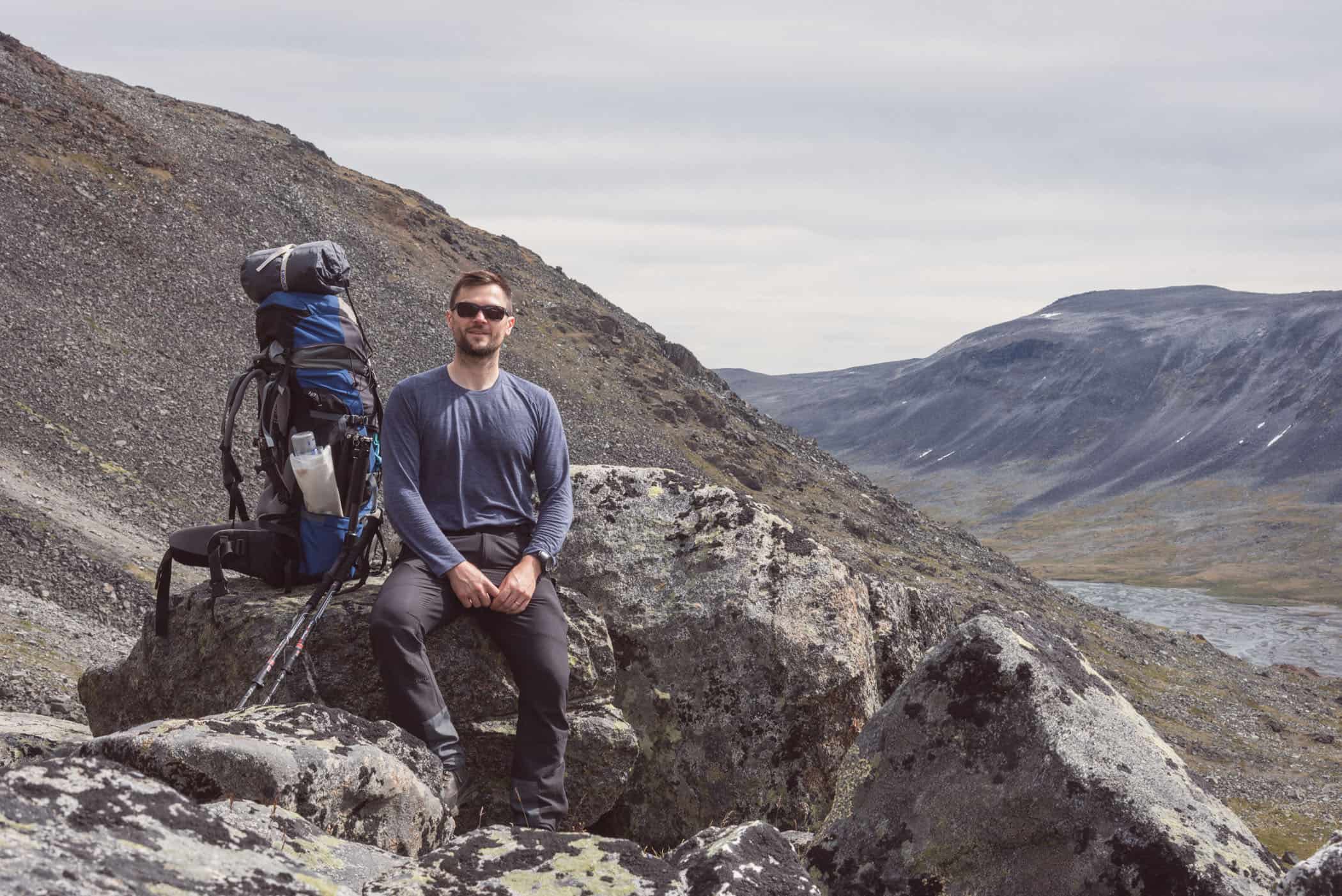


Spitterstulen Mountain Lodge to Leirvassbu hut
I set out in the direction of Leirvassbu, on one of the shortest days on the trek. Trail conditions allowed me to make good progress as the path climbed gently in elevation alongside the Visa River.
For the first three days I was pampered with sun, but 2.5 hours into this fourth leg, the weather turned rapidly when clouds fraternized to a featureless cloaking mist that muffled all sound. Eventually the mist turned into a consistent slight drizzle, which in turn changed into significant rain, leaving the trails muddy and slippery.
I shivered despite the exercise as the freezing damp crept underneath my stiff raingear, and just short of pass summit, facing strong headwinds, I struggled to steady my heavy pack.
Compared to the previous days, today’s climb was mercifully short and upon reaching its highest point, the trail continued on the flat and then gradually descended towards Leirvassbu hut. At the level of Kyrkja Mountain, I caught a first glimpse of the hut set on the shores of Lake Leirvatnet and by the time I arrived, the rain had stopped. I allowed myself one last break for the day before setting out to find a spot to pitch my tent.
track details.
Start: Spitterstulen Mountain Lodge
End: Leirvassbu hut
Route: Spitterstulen Mountain Lodge – Lake Leirvatnet – Leirvassbu hut
Distance: 16.km
Time: 6:10 hours
Elevation gain: 486m / loss: 206m (lowest point: 1125m / highest point: 1480m)

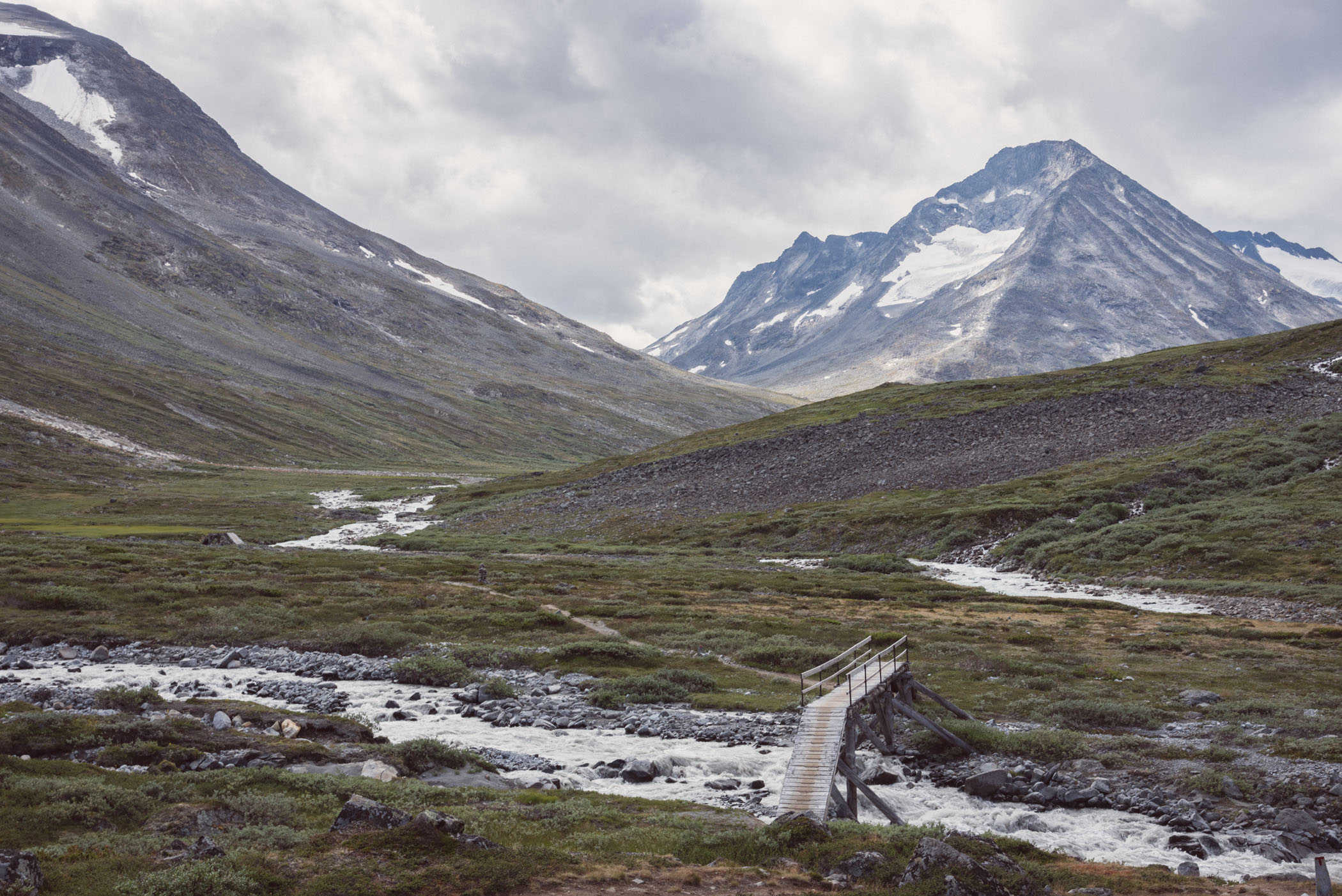

Leirvassbu hut to Gjendebu hut
Heavy rain pelted down on the canvas, crackling on the puddles outside, and keeping me awake throughout the night. I also worried how well the tent would withstand the deluge. My concern was unfounded of course. Why else invest in a Hilleberg tent if not to be absolutely sure it keeps you warm and dry in the worst of rains? It was still pouring down in the morning, so I stayed put in my sleeping bag for breakfast.
Cradling a big cup of warm cocoa, I waited a long time for the rain to abate. When it eventually did, I rushed outside and hurriedly packed up, before rain might set in again. I managed before the next downpour but realized, with some frustration, that as soaking wet as the canvas was, the tent weighed a ton.
Fortunately, it was a short climb to the Hogvaglen pass summit. The long descent to Gjendebu hut at Gjende Lake involved a lot of ‘rock hopping’ though, and saw me scrambling across large boulders strewn across the path. Eventually, after 90 minutes, I arrived on the western bank of Langvatnet Lake, where the trail to Olavsbu hut that extends the route to Gjende by an additional 3-4 hours, forked off to the right.
I instead picked the scenic path, winding along Langvatnet all the way to its lake outlet on the eastern shore, that was a spectacular cascading waterfall. As I continued further towards Gjendebu hut, I noticed cows for the first time in days. Also, grass and shrubs were making way for small birches that became taller by the hour as I reached lower altitudes.
The hike dragged on for much longer than I had expected, but after seven hours I finally reached the hut on the western bank of Gjende Lake. There was a small campsite and a pier for the ferry that twice a day departs to Memurubu, halfway down the lake, and Gjendesheim on the opposite shore.
When I realized that all camping spots in vicinity of the pier belonged to the hut, I retraced my steps and headed towards Olavsbu for a few minutes, where wild camping was again allowed.
track details.
Start: Leirvassbu hut
End: Gjendebu hut
Route: Leirvassbu hut – Hogvalen pass – Langvatnet Lake – Gjende Lake – Gjendebu hut
Distance: 19.1km
Time: 7:00 hours
Elevation gain: 230m / loss: 660m (lowest point: 1000m / highest point: 1540m




Jotunheimen NP to Otta
For the first time in five days hiking in Jotunheimen I set an alarm, so as not to miss the morning ferry to Gjendesheim. Right up until the previous night, I had debated crossing Memurutunga ridge and summit at 1514m to Memurubu, and taking the evening ferry to Gjendesheim from there.
If I had carried only a daypack I would definitely have hiked that extension, however, reassured by the assumption that the views from up on Besseggen Ridge on my first day were probably very similar to those from Memurutunga Ridge, I gave in to the 30kg pack weighing heavy on my shoulders and took the morning ferry.
When the boat arrived, fifty hikers disembarked before an equal number boarded for the return trip. This early in the morning, the sun wasn’t high up in the sky yet, and too weak to take on the stiff breeze running down from the mountaintops. The pale light acted like a filter, and bathed the spectacular rock faces rising to either side of the almost 20-km long narrow lake, in desaturated soft colors.
At the midway stop in Memurubu, half the passengers went ashore and a half hour later we arrived in Gjendesheim, where the bus to Otta was already waiting. The buses and ferrys coordinate departures and arrivals, so there was no risk of missing one or the other.
Leaning back in the comfortable reclining bus seat, I almost drifted off to sleep. I was going to treat myself to two nights in a hotel, an uneventful and lazy spare day in town, and famished for proper food, almost drooled at the thought of a sizzling steak. Thankfully, this was more or less what I got.
The hotel lacked character but provided a comfortable bed, after five nights on an inch of compressed air in a therm-a-rest, I wasn’t asking for more. Solstad Kafé offered a solid burger, even on a day not following a week of ‘trek’n eat’ meals, their food would be good. My spare day however, threatened to turn out not only uneventful but also deadly boring.
A 10-minute walk through Otta revealed four supermarkets and three shops selling sports and outdoor gear – that was it. Fortunately Otta and the nearby town of Sjoa are well known in Norway for whitewater rafting, and thus I spent a half day on the Sjoa River before setting off on my next hike, in Rondane National Park.


